Motion Index:
Body Vertical Movement / Knee Angle / Thigh Angle / Speed fluctuations
When running, the body moves up and down, which is natural due to the repetition of landing and jumping, but the magnitude and atmosphere of the up and down motion is somehow different for different runners and running speeds.
Some of you may wonder what the difference is, since it is a parabolic motion when both legs leave the ground, so it should be the same for any runner.
So here we analyzed the main causes and characteristics of the vertical motion of the body using one citizen marathon runner (male) data.
Vertical movement of upper body, or head
Figure 1 shows the vertical movement of the upper body, or head, position.
The vertical movement of the upper body (head) position in Figure 1 shows that it is lowest during the Left Landing and Right Landing periods, and highest during the period when the legs are apart (the maximum and minimum values are also near the center of each period). (Their maxima and minima are also near the center of each period.)
Also, their respective highest arrival and lowest descent points are different for the left and right landings.
We can see that this is the case.
The reason for this is simple,
The body descends on landing because the knees naturally bend to absorb the landing shock.
The knees then extend and the upper body rises. The point of the switchover is the lowest point.
Once both legs are apart, the rest of the body follows the parabolic motion, reaching the highest point (maximum) and descending again
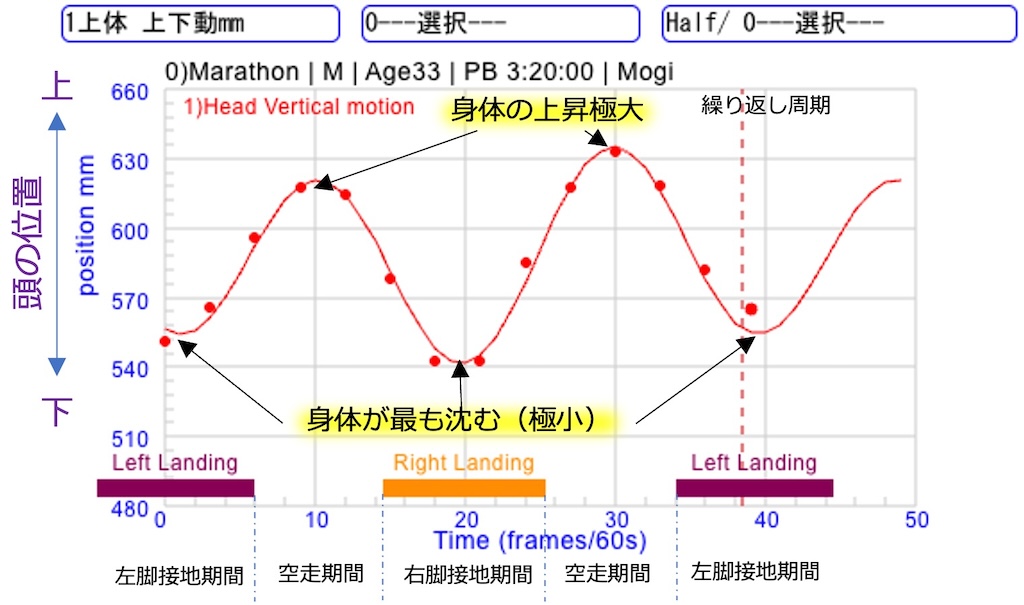
In addition to knee flexion, there is also shock absorption during landing, which varies depending on whether the initial landing is on the fore or heel, the arch of the foot, and the sole of the shoe, but we have not isolated these effects here.
Also, if the trunk is weak, the upper part of the body may tilt forward (hip flexion) or the head may point downward on landing. In this case, most of the runners had a firm upper body and head posture in the environment of form measurement, so we focused our evaluation on knee flexion.
Bent knees on landing
🔹Definition of knee angle
Before looking at the graph, we define the knee angle (Knee_A2).
The photo shows the left and right forms at landing, respectively. The knee angle is 180 degrees when the knee is straight and 0 degrees when the knee is flexed and completely closed.
(Tip: The yellow lines indicating the angles shown in the photos will change depending on the angle of view due to the position of the runner and the camera. When evaluating, they are corrected three-dimensionally and recalculated as the correct angles).
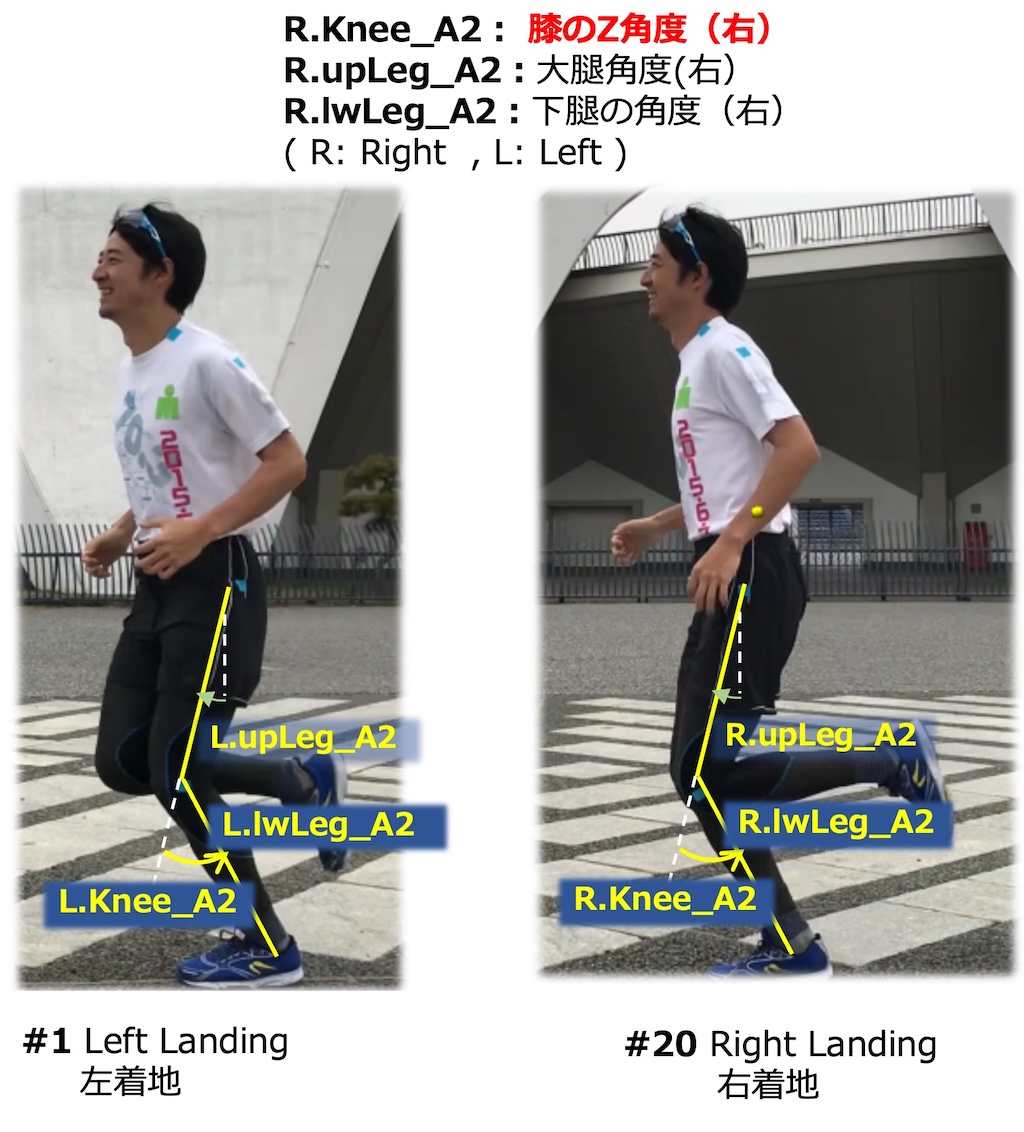
🔹Knee angle change
Next, let’s look at the angular change of that knee (Figure 2).
The green line is the right knee, which begins to bend from the moment it lands, reaching a maximum around #21, and then the knee extends again.
The maximum point of this knee angle change coincides with the maximum descent point of the body.
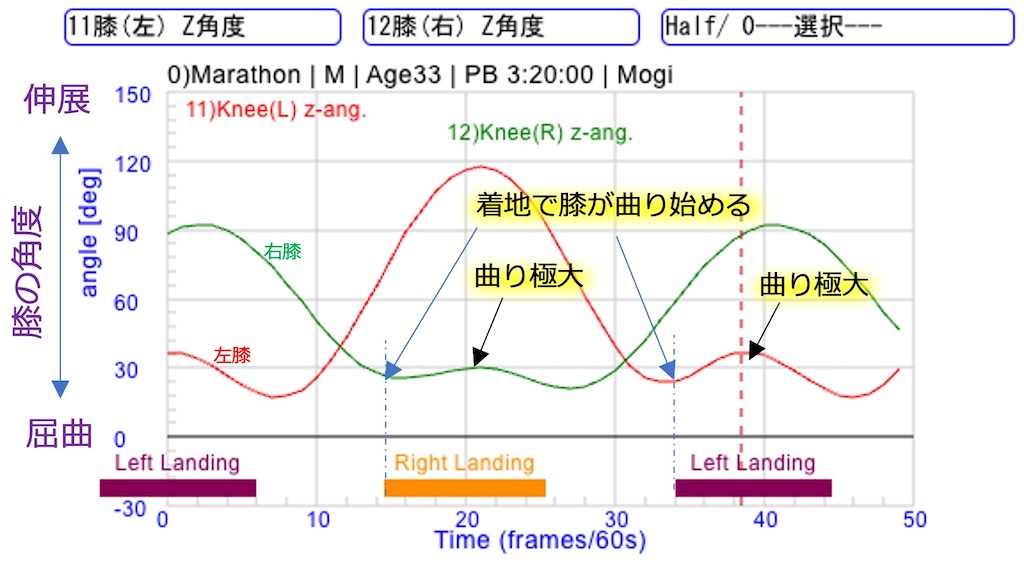
Angle change of right and left thighs
Looking at the angle change of the thigh (upper leg) here (Figure 3), the timing when the body is at its lowest (knee flexion is at its maximum) is almost identical to the timing when the angles of the left and right thighs coincide.
The two forms in Photo 1 of the previous form (frames #1 and #20) are each at this timing.
As you can see from the photos, what is unique about this timing is that it is the moment, around the middle of the landing, when the thigh of the play leg (the leg behind) overtakes the thigh of the supporting leg and comes forward.
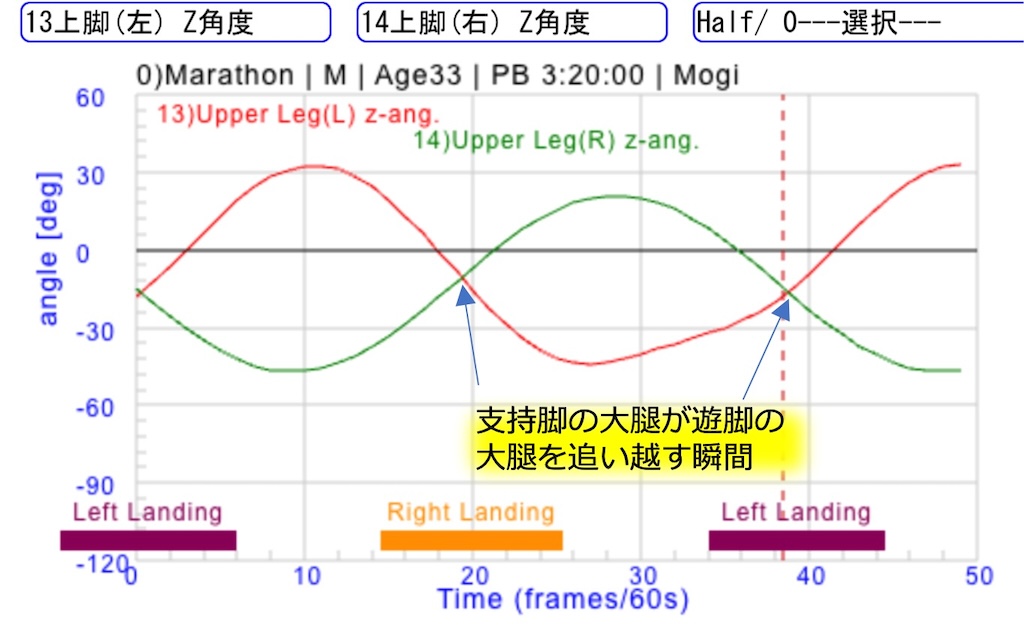
|| フォームの遷移からの加速するタイミング
これまで説明した内容をフォームの遷移(図4)を使って説明します。
(グラフの時間方向が左から右ですが、フォーム遷移では右から左へ時間が進んでいるので注意)
床反力でランニングを解析した論文(阿江通良ほか 日本体育学会 1984の論文を引用した仰木裕嗣のまとめを参照)から、接地の前半は進行方向のブレーキとなり、後半は床を後ろに押して体が加速されることがわかっています。
このことをこれまでの解析グラフと重ねると下記のことが分かります。
- 支持脚が前にある時は減速(ブレーキ)となり、
- 遊脚の大腿が支持脚の大腿を追い越した瞬間から(イラスト中の矢印)やっと、支持脚で地面を後方に強く押すことができ、遊脚を支持脚より前方に強く振り出す(加速する)ことができるようになる
ランニングしている方なら知ってる方もいると思いますが、「速く走るためには後方の脚を出来るだけ速く前に引いて前方に振り出すことが重要」と言われています。そして、加速するには、着地している時に地面からしか推進力をもらえないので、このことは大事ですよね。
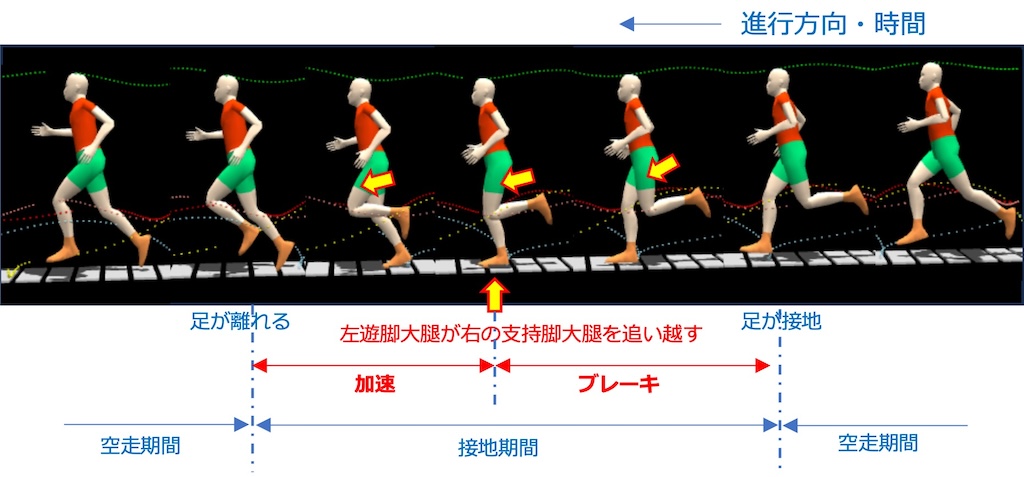
🔹なぜブレーキが発生する? 減らせないの?
先の論文からも、測定の結果全ての速度の走り方にブレーキ成分があることや、速度が速いと床の水平方向の力(減速、ブレーキ)も大きくなることが示されています。
そもそもこのブレーキが現れる具体的な原因、メカニズムは具体的に何だろう?と考えたことはありませんか。さらに、ブレーキを減らせる走りがあれば速くなるはずなのにという漠然とした期待から、自分なりに考えて出た結論が下記です。
(新しいことでは無いのですが、筆者個人の理解の仕方と捉えてください)
「支持脚が接地でブレーキとなることで初めて、遊脚である後ろ足が慣性(惰性で)前に振ることができる」
ちょうど、遊脚の片端が股関節で固定され、反対の端の足は固定されていないので、急に身体が停止(ブレーキ)すれば、固定されていない遊脚は、膝、足が前方に振られるわけです。
下記の棒のアニメのように、片端だけ固定した棒を水平に動かし、急に止めると棒の反対の端や重心は、そのまま進み続けようとするから結果的に、支点を軸に弧を描くように棒は動くことになります。これと同じことが遊脚で起きている自然な現象といえそうです。
一定速度
急に停止
もし、ブレーキが無いとか小さい場合、その分遊脚は前方向へ振れないか遅くなってしまいます。
ということで、後ろ脚を前に持っていかなければいけない走方において、このブレーキは必要なものであり、ブレーキだけ減らすということは意味がない(できない)ことが分かります。
ブレーキの量が変えられないものとしても、遊脚を前に速く振れれば、次の加速するための、脚の振り上げを早く開始でき、早く加速動作に繋げることができます。
すなわち、膝をたたんで脚を実質的に短くする(脚の重心を大転子に近づける)こで、効率的に脚全体を素早く前方に持ってくることができるようになります。
着地後の後ろ脚のリカバーの重要性の「膝をたたんで後ろ足を素早く前にもってこい」とよく言われていることが、物理的にも理にかなったことだとわかった次第です。
|| 速度の変化(減速と加速)
では、みなさんは走っている時に一歩ごとにブレーキと加速を感じながら走っているでしょうか。
短距離走でのスタート開始からトップスピードになるまでなら、加速を感じるかもしれませんが、一定速度になったら一歩ごとに減速や加速を感じにくくなるとと思います。(筆者は残念ながら足が遅いので、うまく体感できません)
とはいえ、実際のところ一歩ごとに減速と加速を本当に繰り返しているのか、どの程度なのか知りたいと思いませんか?
ということで、弊社ではこれを測定しています。
🔹減速(ブレーキ)と加速
図4は進行方向の速度変化の測定結果です。この時のランナーはマラソンの速いペース(3’40″/km、または時速16km/h)で走行しています。
一歩ごとの減速、加速は見られず、左右の脚運びで一つの減速・加速のリズムで走っています。
右脚着地と蹴りで加速され、左脚着地で減速を繰り返してます。
本来、空走期間中は一定速度のはずですが、速度を耳の部分で取得しているのですが、上体が前後に揺れる振動が乗っているのかもしれません。ここは、まだきちんと分離できていない項目です。次の課題にしています。
また、速度変化に関しては個人差が大きく、また、マラソンでは少なく、中距離、短距離走で顕著に発生する傾向にあります。
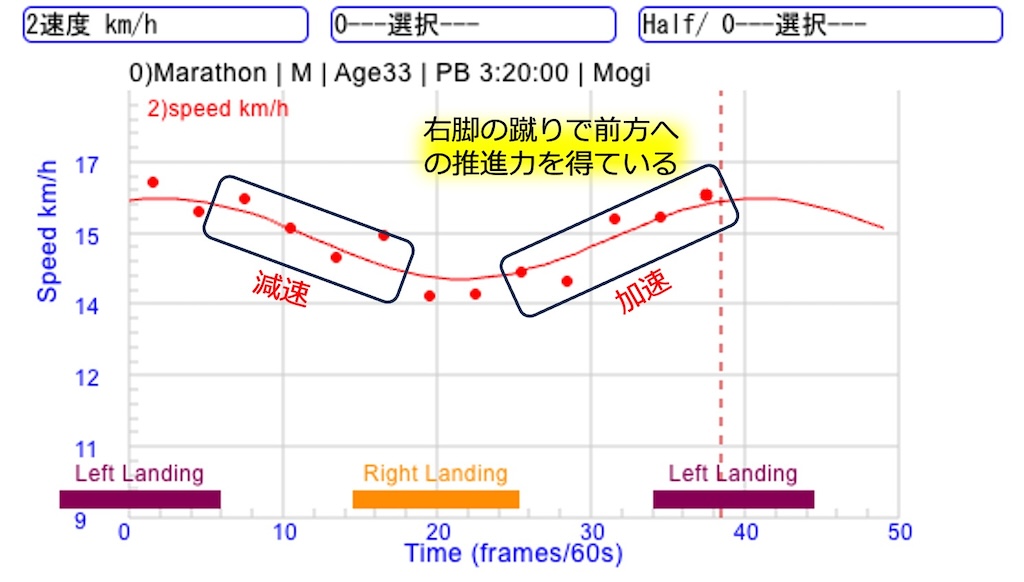
いずれにしても、このランナーの走り方の特徴としては「右脚の蹴りで左脚を前方に振って加速する」という左右差のある走り方をしていることが分かります。その前提で下記のアニメーションをじっくりみると、その傾向が確認できるかと思います。
左右差については、別のテーマとして取り上げていますので、そちらを参考にしてください。
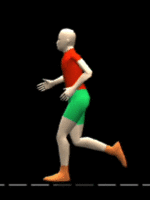
まとめ
着地期間中に身体が最初下降するのは、膝を曲げることで着地衝撃を吸収するため
支持脚(の大腿)が遊脚(の大腿)より前にある間は、支持脚がブレーキの働きをしている
そのブレーキにより、遊脚が慣性力で前方向に振られる
そのため、後ろから遊脚を速く引くには膝をたたんで、実行的な脚の長さを短くする(重心を股関節に近づける)ことが効果的である
最も膝が曲がる時(極大)は、身体が最も下降するタイミングと一致し
かつ遊脚の大腿が支持脚の大腿を追い越す瞬間と一致しているため、減速と加速のモード切り替えがこのタイミングで起きている
それ以降の着地後期は、支持脚で地面を押しながら遊脚を前方向へ、(自分の意思で)強く振り出すことができ、加速に寄与する
|| 参考文献:着地にともなう床反力の測定
🔹 速度増加に伴う地面半力の変化
走った時の地面に対する力のかかり方を、床反力マットを用いて(一歩分のデータを)測定したものです。
低速から高速までの5つの速度の走行時の、水平方向と鉛直方向の力を示しています。
赤線は接地時間(Ground Contact time)が、0.23secなので、マラソンランナの速度とみなしました。
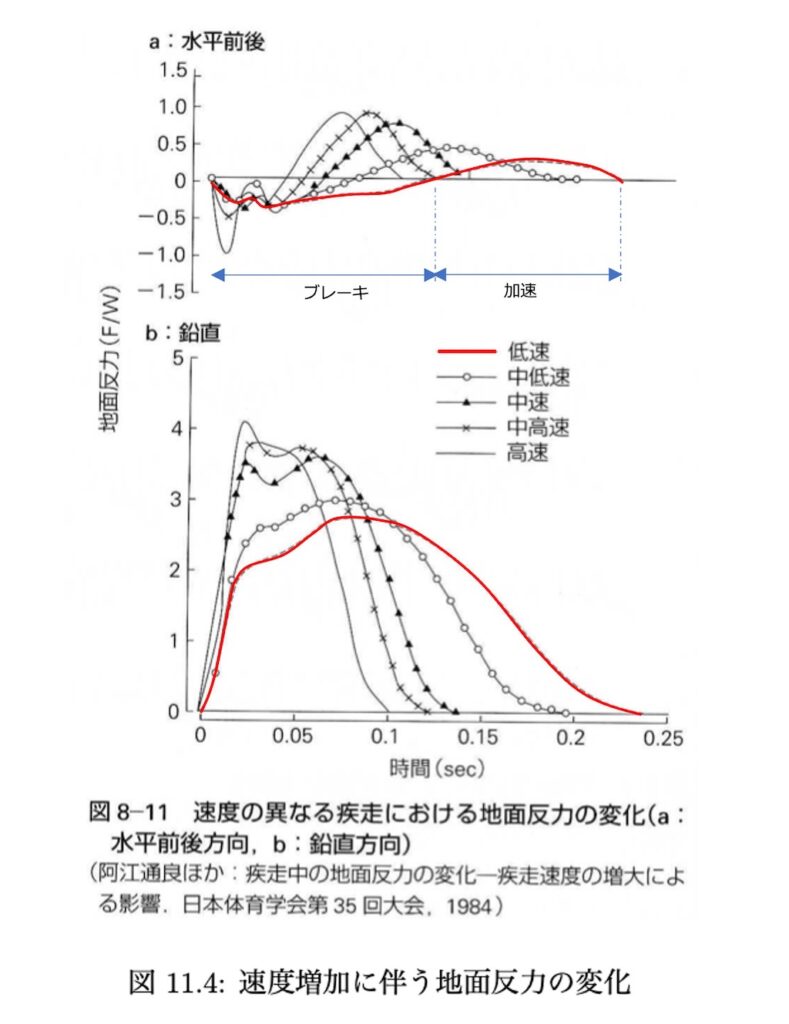
スポーツバイオメカニクス 政策・メディア研究科准教授 仰木裕嗣
https://www.kri.sfc.keio.ac.jp/report/gakujutsu/2008/3-8/SB_09.pdf




